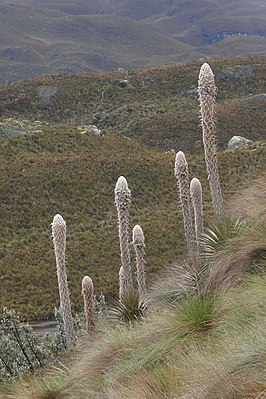Puya clava-herculis
| Puya clava-herculis | ||||||||||||
|---|---|---|---|---|---|---|---|---|---|---|---|---|

Inflorescences |
||||||||||||
| Systematics | ||||||||||||
|
||||||||||||
| Scientific name | ||||||||||||
| Puya clava-herculis | ||||||||||||
| Mez & Sodiro |
Puya Clava-herculis is a plant type from the family of the Bromeliaceae (Bromeliaceae).
The main area of distribution is in Páramos in Ecuador and in the Colombian department of Nariño at an altitude of 3350 to 4200 meters. It was first described in 1904 by Carl Christian Mez and Luis Sodiro .
description
The flower sprout, which dominates the appearance of Puya clava-herculis , is between one and one and a half meters in size and up to four centimeters in diameter. It ends with the double-pinnate inflorescence , whose ellipsoidal or cylindrical shape reaches a diameter of ten centimeters and a length of 17 centimeters. The surface is flaky brown. The lanceolate primary bracts are entire . Their tips towering over the wool of the inflorescence. two to four of the actual flowers are located on small branches of the inflorescence. The bracts of the flowers protrude slightly above the blue-green sepals and resemble the primary bracts. Overall, they are a little smaller than the primary ones. The flower stalks are pressed and short. The leathery petals are 2.5 to 2.7 inches long and pointed.
The leaves are 30 to 40 inches long and 2.5 inches wide. They have a short, egg-shaped leaf sheath . While the top of the leaf is bare, the underside between the leaf veins is covered with white scales. The edges are lightly serrated and have thick, six to nine millimeters long, brown spines that are curved towards the leaf.
literature
- Lyman B. Smith & Robert Jack Downs: Pitcairnioideae (Bromeliaceae) , In: Flora Neotropica Monograph Vol. 14, Part I, 1974

